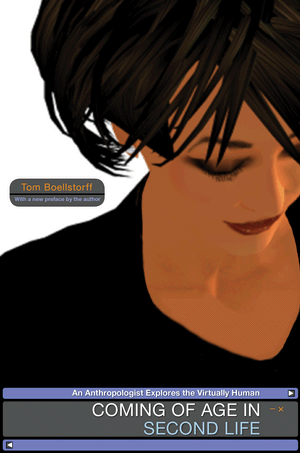I’m a few years late with this, but I recently had the chance to read Coming of Age In Second Life by Tom Boellstorff, an anthropological ethnography of the Massive Multiplayer Online World Second Life. I know this might be an odd book to review, given that it’s nearly 10 years old now and Second Life isn’t quite the juggernaut in the MMO scene that it once was, but the book provides valuable insight for social researcher looking to do research in online worlds. I thought I’d share my opinion about the book so that others could check it out.

First published in 2008, Coming of Age in Second Life is part proof of concept and part by- the-books ethnography of a digital world. With new virtual worlds being constructed each year, Tom Boellstorff set out to prove to the academic community that traditional methods of research could be applied to these rapidly changing, new worlds. Coming from an anthropology background and having done. There have been many ethnographies of online worlds, but Coming of Age may be one of the most groundbreaking and influential.
Boellstorff starts the book by discussing the background of Second Life and painting what a typical day in the world looks like, before moving onto a discussion about the philosophy, ethics, and academic interest in researching such a community. Collecting data and living natively for over 2 years as his online avatar Tom Bukowski, Boellstorff explores various topics of inquiry within this rapidly changing online world. Using traditional anthropological methods and theories, Boellstorff tackles this virtual world with the same keen sense and methods as he would any other social field. Boellstorff does not claim his research to be a definitive guide to MMOs or even Second Life, rather a dive into a very specific era of a constantly changing world.
The crux of the book comes in the forms of chapters dedicated to overarching themes that emerged during Boellstorff’s research: place and time, personhood, intimacy, community, and political economy. In each of these chapters Boellstorff explores more narrowed down sub-themes in discussions that include the anthropological and philosophical background for their importance, and data as evidence for their existence within Second Life. This justification through data comes in various forms, including transcribed interviews with second life citizens, summaries of pertinent events the author witnessed or heard of second hand, and screenshots that give the reader a visual understanding of what the author is expressing. I mention this range of topics to say that the book offers a sort of survey about the world of Second Life during the author’s stay. While your typical ethnography will focus on one individual topic of interest, Boellstorff has the luxury of exploring a world that many of his respondents will have absolutely no experience with; such a luxury is almost impossible in the “real world”.
Throughout the book, Boellstorff is attempting to both prove that traditional methods work in digital worlds, but also argue that humans have always existed between real and virtual, with online virtual worlds being newly enacted forms of traditional culture creation, social interaction, and creativity. By presenting his years of research with precision and thoroughly thought out discussion, Boellstorff’s argument is carefully explored and fought for. The only draw back that I may mention in regards to the book, is that it is at time perhaps a little too academic. This of course is a concession the author must of had to make; either weigh too heavily on public appeal and be ignored by the academic community, or weigh too heavily on the academic side and prove a little dry to the general population. In the end, the book seeks what it sets out to do. For anyone seeking to conduct social research on video games or massive multiplayer online worlds, Coming of Age in Second Life proves to be a useful resource to have on your shelf. Boellstorff’s work exemplify what we students of the social sciences and lovers of interactive media should strive to. You’ll be hard pressed to find a deeper dive into an online world.
I hope this book review has proved worthwhile. I’ll try and recommend other useful books and resources as I come across them.
-Ian L
